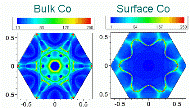Department of Physics and Astronomy: Publications and Other Research
Date of this Version
2009
Abstract
Cross sections for dissociative electron attachment (DEA) to formic acid and glycine are calculated by the resonant R-matrix theory. A model with one effective reaction coordinate close to the O-H stretch motion is employed. The choice of the anion R-matrix pole and the surface amplitude as functions of the reaction coordinate for formic acid are based on scattering phase-shift calculations using the finite element discrete model. For glycine the input parameters are adjusted to reproduce experimental data. The results show that the mechanism of DEA in these molecules is similar to that for the hydrogen halides and involves electron capture into a σ*(OH) orbital so that no σ* &#;π&#; coupling is required. Nonlocal effects play an important role for both molecules. In particular, pronounced steps and cusps are seen at the vibrational excitation thresholds. A sharp threshold peak in glycine is interpreted as a vibrational Feshbach resonance.


Comments
Published in PHYSICAL REVIEW A 79, 042701 (2009). Copyright ©2009 The American Physical Society. Used by permission.